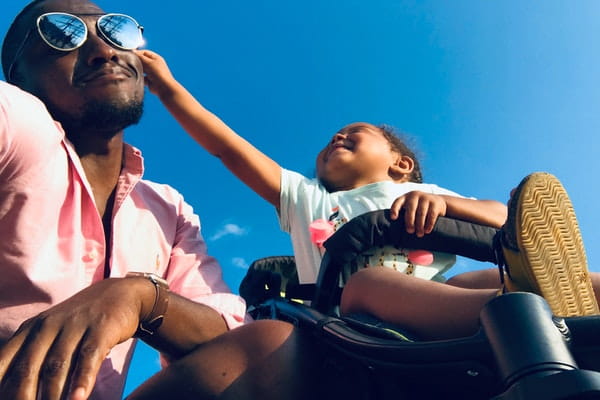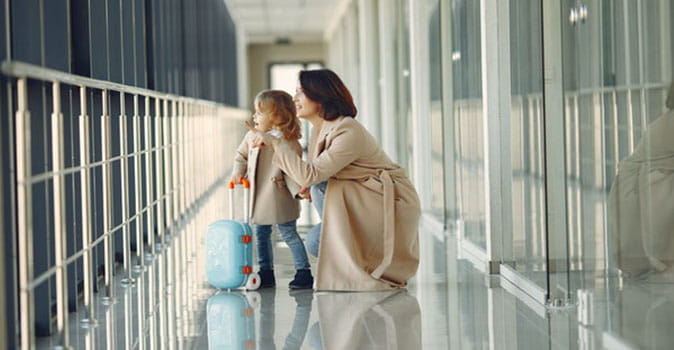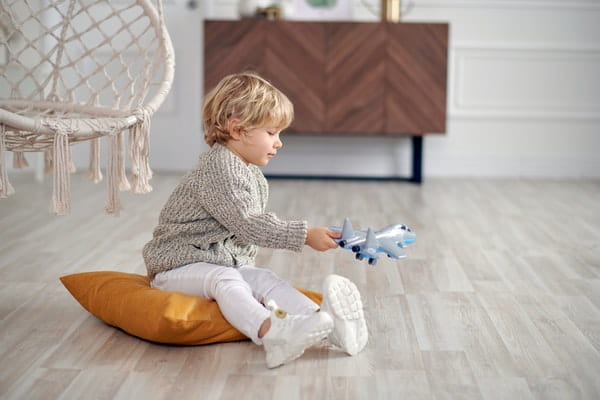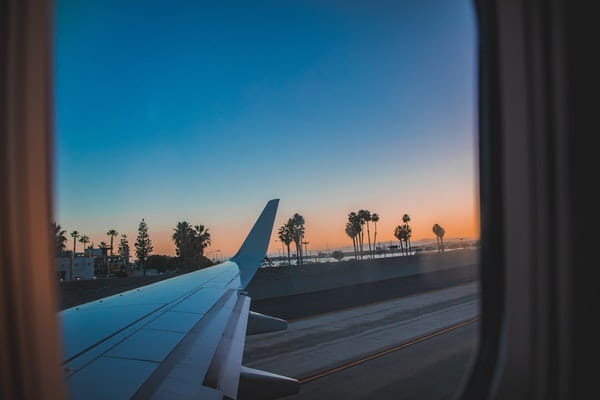Flying with a baby or toddler can get stressful very quickly. But it’s all about preparation. Know what you need to have packed so that you can handle any sticky situations, like a flight delay or a fussy baby.
You can’t always control how your kids will act on their first flight, but you can learn about what systems to have in place to make the journey more enjoyable for everyone.
Jump Ahead
- Flying with Babies (Age 0 – 1 Year)
- Flying with Toddlers (Age 1 – 4 Years)
- Flying with Kids (Age 4+)
Flying with Babies (Age 0 – 1 Year)
Flying with a baby is usually not as difficult as flying with a toddler since babies aren’t as mobile. Many parents swear by certain strategies that ensure their baby is comfortable and sleeps through most of the flight.
Kids under the age of two are not required to have their own seat for a flight, but it is recommended. Many parents like the extra space of a seat for their baby even if they plan to hold them for a majority of the flight.
As many parents know, babies tend to require lots of packing and preparation. The last thing you need is to run out of diapers or wipes because of a delayed flight.
Let’s start with a packing list.

What to Pack
Needs will vary for different babies and families. Use this list to ensure you have your bases covered for the trip.
- Stroller – Strollers are a go-to for traveling with a baby. They are stored in a separate area on the plane for easy access right after landing. Make sure you get a tag for your stroller at the airplane gate. Many parents recommend more lightweight strollers that are foldable for easier travel.
- Car Seat – Car seats are not required but are highly encouraged by the Federal Aviation Association (FAA) and the American Academy of Pediatrics (AAP). Just make sure the seat is approved by the FAA – some, but not all, approved car seats are also allowed by the FAA.
- Stocked Diaper Bag – Make sure you have plenty of diapers, wipes, and formula/breast milk. You will want enough supplies to last through significantly long delays at the airport. A general rule of thumb is to pack one diaper for each hour of flight. Also pack an extra outfit for your baby (and for you) just in case of accidents or spills.
DID YOU KNOW? Formula and breast milk aren’t limited to the 3.4 fl oz rule for airplane carry-on bags. They are allowed in reasonable quantities through security. Just make sure you remove them from your carry-on bag in security and let the TSA officer know. Also, flight attendants are happy to warm up any bottles if needed on your flight.
- Birth Certificate – If you don’t purchase a separate ticket for your baby, you may need to provide a birth certificate verifying the child is under the age of two – the maximum age for sitting on a parent or guardian’s lap during a flight. Check with your airline before traveling.
- Passport – Most countries require everyone – including babies – to have a valid passport in order to travel. If you are traveling internationally, make sure your baby has a passport too.
PRO TIP! A common struggle parents face when traveling with a baby is helping them adjust their ears as the pressure changes. The strategies used by adults like chewing gum or yawning aren’t practical for babies, so here are some other ways you can help your baby protect their ears:
- Feed your baby at takeoff and descent – when the air pressure changes most dramatically. The swallowing motion will help your baby pop their ears and become more adjusted.
- Give your baby a pacifier to suck on. The sucking motion can mimic the motions needed to adjust your baby’s ears and make them more comfortable.
- Bring pain relievers like acetaminophen if your baby is experiencing a cold or ear infection. Check with your doctor about whether your baby should fly with an infection and how much pain medicine to give.
- Massage your baby’s ears. If your baby isn’t up for the other strategies, simply rubbing your baby’s ears could help sooth some of their pain.
Tips for Flying with Babies
There are many tactics parents use to make their baby more comfortable and their flight more enjoyable for everyone. See the tips below.
Find the Nursing Area at the Airport
Long delays can easily make a trip more stressful. Many airports now offer designated nursing areas. This is a great place that is quiet and private for feeding before a flight and during long delays.
Check your airport’s map online before traveling to see if there is a nursing area. You can also ask an airport representative when you get there.
Board Early
Families with babies are often allowed to board the airplane first. Many parents appreciate this time to get settled into their flight before it starts to get crowded with people.
As an early boarder, you won’t need to worry about getting in anyone’s way. Take this opportunity to get the car seat situated and tuck any extra carry-on luggage into the overhead compartment.
This can also be a great time to get to know any other parents who are also boarding the flight with kids or young babies.
Feed at Takeoff and Landing
Many parents recommend feeding at takeoff and landing. With the change in altitude, babies can easily get scared or uncomfortable due to the pressure changes. Feeding is a great way for your baby to adjust their ears and be more comfortable for the flight.
This also means your baby will be more likely to sleep for the duration of the flight, which will make it an easier flight altogether.
Purchase an Extra Seat
Even though children under the age of two aren’t required to have their own seat, many parents recommend purchasing one anyway. The extra space can be very helpful when handling a newborn during the flight – especially if it is a longer flight.
No one anticipates flight delays or cancellations while traveling, but it’s wise to be prepared for when it may happen. Find out how to handle a delayed or canceled flight before your next trip.
Flying with Toddlers (Age 1 – 4 Years)
Once kids reach the toddler age, flying can become a bit more difficult. Keeping them entertained for the duration of the flight is often the most challenging part.
At this age, kids are either crawling or walking around and don’t like to be confined to their seat. Make sure you pack plenty of toys and distractions for a flight. Keep flights on the shorter side since kids these ages have such short attention spans.
What to Pack
Check out this list of travel essentials for keeping toddlers entertained and happy during the flight.
- Stroller – A stroller is a must-have for family travel with toddlers. Make sure you get a tag for your stroller from the airline representative before boarding. It will be stored in a separate area during the flight but will be easily accessible once you land.
- Car Seat – Car seats are not required but are highly encouraged by the FAA and the AAP. Just make sure the car seat is approved by the FAA – some, but not all, approved car seats are also allowed by the FAA. Remember that kids over the age of two must have their own seat.
- Stocked Diaper Bag – Make sure you have plenty of diapers and wipes or pull-ups. You will want enough supplies to last through significantly long delays at the airport. Also bring an extra outfit for your toddler (and for you) in case of accidents on the plane.
- New Toy – Many parents recommend surprising a toddler with a new toy for their flight. Many cite that the biggest struggle is keeping the child entertained for the entire flight. Introduce a new toy to help keep your child distracted.
- Birth Certificate – If you plan to have your toddler sit on your lap for the entire flight (remember: this is only allowed for children under the age of two), you may need to provide proof of age with a birth certificate. Contact your airline before flying to verify whether this is necessary.
- Passport – Most countries require everyone – including babies – to have a valid passport in order to travel internationally. Make sure your child has one before you plan to travel across the border.
- Snacks – Food is a must for growing toddlers on a plane. Keep kids from yelling or whining by packing one or two of their favorite snack options for the flight. This can be especially helpful for picky kids who don’t like any food offered by the airline. Ensure you have bottled water as well to avoid dehydration on your flight.
DID YOU KNOW? MRSA (Methicillin-resistant Staphylococcus aureus) and E. coli are common in environments like airplanes, where groups of people are crowded together in a tight space. In 2014, Auburn University researchers found that MRSA can live on the seat-back pocket of an airplane for a week, while E. coli can survive on an airplane armrest for four days.
Infection with MRSA can cause skin diseases and pneumonia, and E. coli can be especially dangerous to young kids. E. coli can lead to severe diarrhea and hemolytic-uremic syndrome, a disorder which is more frequently fatal in children under five years old.
Thankfully, the following hygiene practices can lower your risk:
- Use disinfecting wipes to wipe down seat-back pockets, tray tables, armrests, seatbelt buckles
- Ensure your children wash their hands after using the airplane bathroom
- Don’t allow your kids to eat directly off tray tables
Read "The Ultimate Guide to Safe and Healthy Family Travel" for more tips on how to plan a safe and healthy family vacation.
Tips for Flying with Toddlers
Flying experiences can be different for every family with a toddler, but the tips below may help make the experience more enjoyable.
Prepare Your Child
Before you travel, talk to your child about the trip. Explain what it will be like being on an airplane and get them excited for the new experience. This kind of preparation can help scared children be more comfortable and even look forward to their first flight.
Many parents recommend reading books to kids about airplanes and flying to help familiarize them and associate flying with positivity. The mere experience of flying for the first time and looking out the window can keep a toddler entertained for a surprising amount of time.
Bring Various Options for Entertainment
Kids can get bored easily during the long time in their seat. Make sure you’ve brought plenty of modes of entertainment like toys, movies, games, and coloring books.
You can even point out different parts of the airplane like windows, reading lights, pull-down tables, and more. As a last resort, you can walk down the aisle once or twice with them. Just make sure you avoid flight attendants and refreshment carts.
Burn Off Energy Before the Flight
One way to keep a toddler calm during a flight is to let them run around and burn off energy before the flight. Some airports offer kids play areas to help keep kids entertained. If there isn’t a designated play area for kids at your airport, a few laps through the terminal can make a big difference in calming them down for the flight ahead.
Board Last
Unlike families with babies, many parents recommend that families with toddlers board last. The later you board the plane, the less time your toddler will be confined to their seat in the plane. Consider the pros and cons of boarding last and decide what is best for your situation.
It’s important to be cautious about safety when traveling to a new place with kids. Read about the best tips for staying safe when traveling with kids.
Flying with Kids (Age 4+)
Kids age four and up are more independent than younger children. They tend to be better at controlling their emotions and entertaining themselves, but still rely heavily on parents or guardians to make it through a flight smoothly.
Flights with kids this age could mean working together to decide what to bring for the flight. Kids four and older can also get nervous about flying if they have never done it before. Talking through the process beforehand can help ease nerves.
What to Pack
- Stroller – Strollers tend to be less necessary as kids get older, so gauge whether you think one is necessary. They can be helpful for longer walks through the airport, but not ideal if you’re trying to save space.
- Car Seat – Car seats aren’t required for children to fly, but they are recommended by the FAA and AAP. Make sure all car seats are approved by the FAA before you fly.
- Passport – Make sure you child has a passport if you plan to travel internationally. Most countries require everyone – including children – to present a valid passport.
- Toys/Games – Pick out which toys or games to bring with your child. Kids this age tend to have a longer attention span than toddlers, so even watching a movie on an iPad can keep them calm and entertained for a while.
- Snacks – Ward off any grumpiness with one or two snack options for your kids. Healthy snacks like raisins, whole grain crackers, and fruit will help your child feel full longer and avoid the hyperactivity and crash that results from too much sugar. Packing your own snacks is also much more affordable than buying it from the airport or airline. Ensure you have bottled water for your child to drink as well, as young children can become dehydrated rather quickly.
Attempting to conquer potential jet lag? Sleep masks and ear plugs (or noise-canceling headphones) may encourage your child to sleep on a daytime flight if necessary. See additional tips for preventing jet lag here.
Tips for Flying with Kids
Check out these tips for traveling with kids so you feel more prepared for the experience.
Talk Kids Through the Experience
A great way to make kids more comfortable with flying is to talk them through the experience before leaving for the airport. Tell them about each of the stops they will take like luggage checks and security.
Not only will this help kids get more excited for the flight, but it can also help kids keep up with you knowing there is more excitement to come at the airport.
Board Last
Like toddlers, it’s often ideal to board last with a kid who has lots of energy. A few extra laps in the airport could mean a calmer plane ride in general.
Some parents may prefer to board earlier to get settled before the plane fills up, but often with older kids there isn’t as much to get settled. Plus, this means the child is confined to their seat for a shorter amount of time.
Choose a Longer Layover
If you must have a layover between flights, lean towards a longer one instead of a shorter one. Moving across an airport can take much longer with one or more kids, so the extra time could mean the difference between arriving to your gate on time or not.
Prepare for Air Pressure Changes
If your child has recently recovered from an ear infection, check with your doctor before flying. Kids are very prone to infections, and this can make the flying experience much more painful.
Give kids something to drink right after takeoff and for the last 30 minutes of descent to help them adjust to the changing pressure. Gum can also be beneficial if your child is old enough to safely chew it. Chewing gum opens the eustachian tube, which allows air into the middle and inner ear that evens out the pressure.
PRO TIP! If you know your child will suffer ear pain on the plane, consider providing a child-safe pain reliever 30-60 minutes before takeoff to help ease the pain.
A Final Note
You can prepare as much as possible for a flight with kids, but sometimes you can’t prevent a tantrum in the middle of the airport or on the plane.
Many parents may feel embarrassed, but all you can do is your best for the flight. Other parents on the flight are sure to understand the struggles of making it through a flight without one outburst.
Just remember to remain calm and expect the unexpected for your trip.



